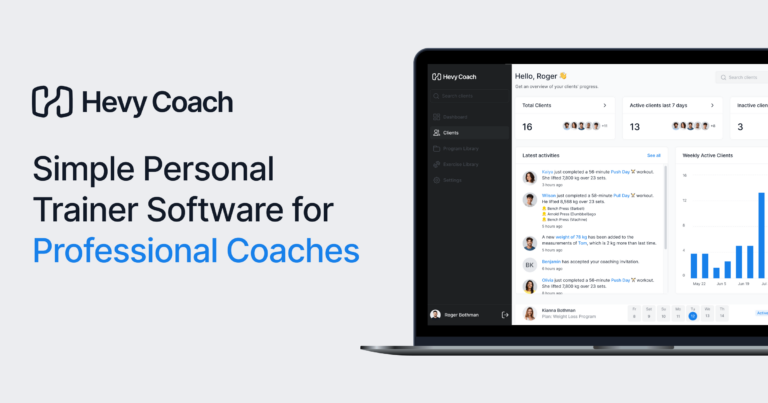Building a successful personal training business involves more than just writing training plans for your clients.
You must do a lot of behind-the-scenes work to set yourself apart and help your clients succeed. Part of that work includes the use of personal trainer consultation forms.
Asking the right questions allows you to examine new clients and keep track of their performance to make adjustments when necessary.
The problem is that there are multiple forms, each with unique questions and criteria, which can be overwhelming for personal trainers. Our guide breaks down the various personal trainer forms and teaches you how and when to use each for success.
Let’s discuss.
What are Personal Trainer Consultation Forms?
A personal trainer consultation form allows fitness professionals to gather relevant client information. The information guides the coaching process and helps trainers determine if they would be a good fit for a client.
Key pieces of information include:
- Personal information
- Health and injury history
- Fitness goals
- Lifestyle information

Try Hevy Coach
Intuitive personal trainer software, with a world class experience for your clients.
30 day free trial, no credit card required
What Makes Personal Trainer Consultation Forms Important
Forms provide the necessary context to help trainers better understand their clients: injury history, health status, fitness experience, goals, workout preferences, etc.
As a trainer, you’re expected to write training programs revolving around resistance exercise, but the exact routine will largely depend on the client.
It’s one thing to work with a 20-year-old who wants to get stronger for football and a whole other to help seniors move more freely and become independent in their daily lives. Both could benefit from resistance exercise, but their workouts will differ significantly.
Being on the same page with clients is also important for liability reasons. Ensuring safety should always be your number one priority, and it’s crucial that clients understand what they must do to stay out of harm’s way.
Related article: Personal Trainer Questionnaire: Why and How (+Example Questions)
Types of Consultation Forms (Their Importance for Personal Trainers)

1. Initial Consultation Form
This is the first consultation form used during the first meeting between the personal trainer and the client. It includes basic information like the client’s name, age, gender, fitness goals, and health history.
2. Health History Form
A health history form dives deeper into the client’s past to uncover health conditions, allergies, injuries, surgeries, or chronic illnesses. A trainer must use this form to determine whether they would be a good fit for a client.
3. Physical Activity Readiness Questionnaire (PAR-Q)
Also known as a PAR-Q form, this is a self-screening tool clients can fill out themselves to determine if they are ready to go on a structured exercise program. All the answers are yes-or-no; clients can start working out if they answer ‘no’ to all questions.
4. Lifestyle Questionnaire
Trainers should use lifestyle questionnaire forms to learn more about clients and their habits––diet, alcohol consumption, smoking, activity outside the gym, stress levels, etc.
Using such a form is beneficial because it allows trainers to better understand their clients and what roadblocks they might face on their fitness journeys.
5. Fitness Assessment Form
A fitness consultation form is helpful for trainers to record the results of various tests, such as performance on specific exercises, body fat percentage, flexibility, and balance.
Trainers should use such a form during the first session to establish a baseline and at regular intervals afterward to track progress.
Related article: Personal Trainer Assessments: What are They (and Why You Need Them)
6. Informed Consent Form
This document outlines the potential risks of physical activity and ensures that the client understands and accepts them.
It’s a good idea for trainers to use such a form because it can offer legal protection in case of an injury. Of course, trainers should also look into insurance to protect their business and assets.
7. Personal Training Agreement Form
Also known as a client agreement form, this document outlines the terms and conditions of the personal training services.
It includes information about the services provided, what clients can expect from their trainer, what’s required of the client, payment terms, cost, schedule, cancellation terms, etc.
Do Trainers Need to Use All These Forms?
While each form serves a unique purpose, trainers don’t usually have to use all of them on every client. The ones you decide to use will depend on the context––the client, their needs, etc.
Perhaps a better approach is to blend most of these. For example, the initial consultation form can include sections on health and lifestyle. That way, trainers can collect the relevant information more effectively without overwhelming themselves or their clients.
The most important forms trainers should use are:
- Initial consultation form to get to know the client
- Health history form to understand the client’s potential limitations
- Informed consent form for the client to understand and accept the possible risks
- Personal training agreement form to clarify the conditions of the coaching services
The Art of Crafting Effective Consultation Questions
Crafting good consultation questions is a delicate art that requires balance, empathy, and the ability to frame questions in a way that encourages insightful and thorough replies.
Striking a Balance Between Open and Close-Ended Questions
Open-ended questions are the ones clients can’t answer with a simple ‘Yes’ or ‘No.’ These take longer to answer but encourage people to share more about themselves, the problems they face, and what they look for in a personal trainer.
As a side note, pay careful attention to the language people use and how they frame the issues they face. These things can help you craft better marketing messages in the future.
Close-ended questions are easier to answer but aren’t nearly as insightful. Their primary purpose is to gather basic information quickly.
The key is to balance these two types of questions so clients can go through the questionnaire relatively quickly but still share all the necessary information.
Why Empathy is Crucial When Asking Questions
People need to feel understood and valued. By showing that you understand their situation and can show compassion, you set yourself apart from your competition and instantly form a connection with the new client.
For example, let’s say that a client has had a bad experience with a personal trainer. Instead of asking them, “Why did you choose to stop exercising.” reframe the question:
“Can you share some information about your previous experiences that could affect your willingness to work with a fitness professional now?”
Framing Questions for Success
Trainers must learn how to frame their questions in an empathic and non-judgmental way to get clients to open up and share vital information.
A trainer must not blame the client for past failures or setbacks but instead foster a judgment-free zone where open communication helps create a strong relationship.
Occasional tough love can be helpful, but it’s best to leave it for extreme situations and only after building rapport with the client. After all, you don’t want to appear like a drill sergeant to someone who isn’t entirely sure they even want to be at the gym.
Using the Consultation Form to Guide Training Plans
Asking clients to fill out questionnaires, figuring out the best way to store all that information for every person you coach, and regularly referring to it can be frustrating. However, taking the time to do so can benefit your business and boost client satisfaction.
Personal trainer forms are jam-packed with valuable information that helps you better understand each client and their unique situation. It allows you to produce superior training programs that consider even the smallest details.
For example, let’s say that a client has a history of lower back pain. Knowing that allows you to prescribe exercises that don’t aggravate the area but still get the job done.
Maybe deadlifts don’t work for that person, but they could still do accessory and isolation lifts to target the erector spinae, glutes, and hamstrings. Good examples of such activities could include glute bridges, seated/lying hamstring curls, bird dog, and hip thrusts.
Adjust Based on Feedback

Consultation forms aren’t one-and-done things. Instead, they are tools you should use to stay on top of things and find new and better ways to serve your clients.
For example, if a client finds a particular exercise too difficult to perform and becomes discouraged, the trainer must find a substitute. The same goes for other training variables––number of sets, rep ranges, load selection, weekly workout schedule, etc.
Final Words
Consultation forms are essential for personal trainers. They allow coaches to gather valuable information about their clients and receive feedback that helps them determine what changes they might have to make.
The four essential intake forms for personal trainers are the initial consultation form, a health history form, an informed consent form, and a personal training agreement form.

Try Hevy Coach
Intuitive personal trainer software, with a world class experience for your clients.
30 day free trial, no credit card required
Before you go:
Check out Hevy Coach––our all-in-one platform designed for personal trainers. It allows you to create workout plans for clients, make adjustments when necessary, track their progress, and much more, all from a single dashboard.




